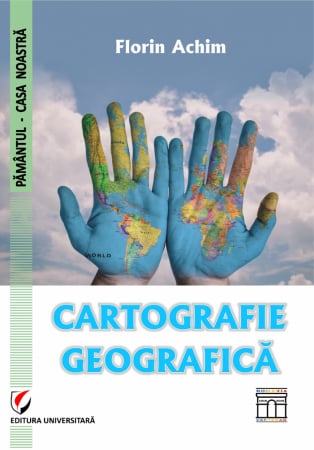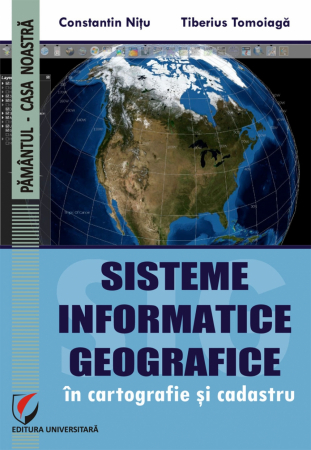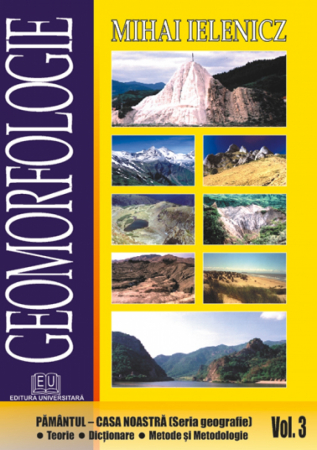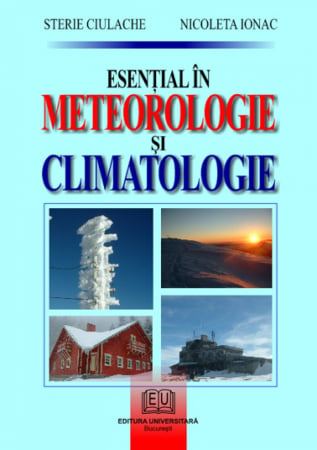Publisher: Editura Universitară
Author: Florin Achim
ISBN: 978-606-28-1225-6
DOI: https://doi.org/10.5682/9786062812256
Publisher year: 2021
Edition: I
Pages: 184
- Description
- Download (1)
- Authors
- Content
- More details
- Reviews (0)
In the study of geography, there are a number of disciplines that are meant to ensure the preparation of students for research and the use of research tools in order to obtain information and results. In recent decades, the rise of remote sensing has been observed in geographical studies and research, increasingly highlighted by the development of computer tools and programs and their use in education.
For geography, remote sensing is, along with the above, also a study discipline designed to present the principles and methods specific to this field, considered rather technical, with the role of remote observation on the elements of the geographical environment.
This paper, entitled "Remote sensing elements applied in geography", in accordance with the content, aims to present an applied version of remote sensing, dedicated to the geographical field. As geography itself can be studied in specializations such as: environment, planning, meteorology - hydrology, cartography and tourism, or geography itself, and the object of study has a special complexity and especially a spatial development and temporal dynamics, we can says that remote sensing brings possibilities for exploration through its products, such as images, for all this, thus constituting a direction of its own, which we can even call geographical remote sensing.
In the content of the paper, remote sensing is defined and presented through its field of concern, both as a whole and from the point of view of the contribution it brings to geography, its branches and profile specializations. The chapters of the paper are focused on the study of the basic branches of remote sensing, and for each of them the points of geographical interest are highlighted, being examples of analysis on some processes and phenomena, as well as moments or projects for terrestrial research, as well as from the space of the Universe.
This book is a course support for the introduction in the field of remote sensing, addressed to geography students at the undergraduate level. Of course, the topic, with the notions of remote sensing, can be done at any stage of professional activity, especially when, through the projects followed, we are put in contact with remote sensing images and especially with their exploitation. Although it is a work written in an accessible format, in order to understand the content, it is necessary to have profile knowledge or studies carried out in parallel, related to cartography, informatics, but also other disciplines from the category of the fundamental ones for geography. The book is the result of a long activity, related to training and teaching, it is based on an intense documentation, and all this has led to an authenticity of the content, which is directed, during the chapters, to the sphere of geography, including by combining geographical terms with those of remote sensing.
Lect. univ. Dr. Florin ACHIM
-
Remote Sensing Elements Applied in Geography
Download
Preface / 9
Introduction / 13
Chapter 1. Remote sensing - definition, general data / 15
1.1. The definition of remote sensing and its importance for geography / 15
1.2. Sciences, disciplines and support fields for remote sensing / 17
1.3. Remote sensing branches / 19
1.4. History of the appearance and development of remote sensing / 21
1.5. The use of remote sensing in different practical and scientific fields / 22
Chapter 2. Study and research directions, specific to remote sensing / 24
2.1. Terrestrial research / 24
2.2. Universe Research / 25
Chapter 3. Remote sensing and electromagnetic spectrum / 36
3.1. Electromagnetic spectrum definition and spectral signature / 36
3.2. Genesis of electromagnetic radiation and their sources / 36
3.3. Behavior / radiation / electromagnetic when passing through the atmosphere and when interacting with different media and elements (transmission, propagation, amplification, reflection, refraction, diffraction, dispersion, diffusion, absorption, interference) / 39
3.4. Characteristics and properties of electromagnetic radiation / 44
Chapter 4. Satellite remote sensing / 48
4.1. Definition and general data / 48
4.2. Remote sensing satellites, general aspects / 49
4.3. Launching artificial satellites into orbit and their launch centers / 49
4.4. Flight and orbital characteristics of satellites / 51
4.5. Satellite remote sensing systems / 53
4.5.1. Landsat / 53
4.5.2. Meteosat / 53
4.5.3. QuickBird / 54
4.5.4. Aster / 55
4.5.5. Icons / 56
4.5.6. Wordwiew / 56
4.5.7. SkySat / 58
4.5.8. TerraSaR / 58
4.5.9. Pleiades / 59
4.5.10. KOMPSAT / 60
4.5.11. SPOT / 61
4.5.12. Sentinel / 62
Chapter 5. Ways of obtaining remote sensing images / 63
5.1. Passive means of remote sensing / 63
5.2. Active means of remote sensing / 64
5.2.1. Multispectral means / 65
5.2.2. Radar / 67
5.2.3. The leader / 69
5.2.4. Sonar / 70
Chapter 6. Results (products) of remote sensing activities / 71
6.1. General aspects / 71 6.2. General characteristics of remote sensing products / 72
6.2.1. General characteristics / 72 6.2.2. Geometric features / 75
6.2.3. Photographic or visual characteristics, lateral displacement effect, topographic effect and radial effect / 78
6.3. Aerial photographs / 83
6.3.1. Orthophotoschema orthophotoplan doublet / triplet / orthophotoplan tape / 84
6.3.2. Stereoscopic model, anaglyph method, photoredirection, corrections / applied / aerial photographs, aerotriangulation and various image processing / 87
6.4. Satellite images / 91
6.4.1. Classifications and characteristics / 91
6.4.2. Scale and different types of resolution (spatial, spectral and temporal). Spectral indices. Histogram / 94
6.4.3. Databases and metadata, specific to satellite images / 101
6.4.4. Corrections / applied / images / satellite (geometric, radiometric, atmospheric, filter application) / 102
Chapter 7. Analysis and interpretation of remote sensing images / 105
7.1. Principles of analysis and interpretation / 105
7.2. Criteria for analysis and interpretation / 111
7.2.1. Direct criteria / 112
7.2.2. Indirect criteria / 118
Chapter 8. Remote sensing applied to geographical branches and other sciences or fields close to it / 127
8.1. Use of remote sensing for meteorology and climatology / 127
8.2. The use of remote sensing in the study of inland waters / 135
8.3. Use of remote sensing in the field of oceanography / 139
8.4. The use of remote sensing in glaciology / 142
8.5. Use of remote sensing in the field of geomorphology / 146
8.6. The use of remote sensing in the field of pedology / 148
8.7. The use of remote sensing in vegetation analysis / 150
8.8. Using remote sensing for wildlife study / 151
8.9. The use of remote sensing in the field of ecology / 154
8.10. The importance of remote sensing for geography and for specific research / 155
8.11. The relationship between remote sensing and cartography / 156
8.12. Remote sensing of geographical risks / 156
8.13. Using remote sensing to identify mineral resources / 158
8.14. Remote sensing applied in archeology / 160
8.15. Remote sensing applications in the field of spatial planning / 161
8.16. Remote sensing applied in land use / 162
8.17. Use of remote sensing means in cadastre / 164
8.18. Using remote sensing in space planning / 165
8.19. The use of remote sensing in forestry / 166
8.20. Use of remote sensing for agriculture / 169
8.21. Remote sensing in the field of transport / 173
8.22. The use of remote sensing in the military field / 173
8.23. Use of remote sensing in the investigation of aviation, naval, industrial and rescue accidents / 176
8.24. The use of remote sensing in the didactic activity / 179
Bibliography / 181
The course "Elements of remote sensing applied in geography", developed by lecturer Dr. Florin Achim, is intended for students from the specializations "Territorial Planning" and "Meteorology - Hydrology" within the Faculty of Geography of the University of Bucharest. It responds to an essential requirement of higher education: the acquisition and use by future professionals of the most advanced techniques and methods for investigating the geographical environment. Remote sensing is one of them, making it possible to observe with great accuracy the earth's surface, the acquisition and exploitation of a huge volume of information (images and measurements) about the Earth, about the elements and phenomena in our living environment.
We understand why the author was concerned that, from the first pages of the course, to clarify the content of the terms "remote sensing" and "geographical remote sensing".
Regarding the term "remote sensing", it would first resort to the strictly etymological meaning, that of remote sensing, and then to reach the acceptance of the technique of observing the Earth and the Universe. Moreover, remote sensing is considered a technology in which certain stages and operations follow one another. Indeed, remote sensing - we refer to space remote sensing - involves a flow of technical operations: remote capture (airspace, outer space) of electromagnetic waves emitted or remitted from the earth's surface using sensors installed on board aerial platforms (aircraft, helicopters, drones) or on space platforms (especially satellites, but also space stations and probes); transmission of information (also electromagnetic waves) to earth stations; transformation of electromagnetic waves into digital images and maps, into quantitative indices and their storage; processing images / geospatial data and making derived documents (images in natural and false colors, images in certain spectral bands and composite images; satellite / spatial maps; Numerical Terrain Models / DEMs; sets of qualitative and quantitative indices regarding the constituents of the terrestrial environment: air, inland and ocean waters, vegetation and soils, rock and relief, settlements, agricultural crops, land transport routes, etc.); dissemination of results, respectively delivery of specific products to different users in the field of scientific research and in the field of practical applications.
The phrase "geographical remote sensing", which we retain from the course content, is explained by lecturer Dr. Florin Achim by the diversity of applications that aerial photographs and satellite images have in current geographical research.
In the course structure we find, in the first part, the chapters regarding the physical and technical bases of remote sensing: the principles of electromagnetic remote sensing, the structure of the electromagnetic spectrum, the behavior of electromagnetic waves emitted or remitted by the earth's surface (reflection, refraction, diffraction, absorption, diffusion). . Then, the content is carried out on the two branches of remote sensing: aerial photogrammetry and spatial (satellite) remote sensing. The largest share is held by the chapters on satellite remote sensing. We note here that in Western professional environments, the term remote sensing applies only to satellite remote sensing (remote sensing). Also, the remote sensing of the Earth from space is designated by the expressions "Earth Observation", respectively "Earth Observation", "L'Observation de la Terre".
These chapters cover a number of specific topics: remote sensing systems (passive remote sensing and active remote sensing), remote sensing sensors (television cameras, radiometers, radars, lidars) and satellite imaging (image processing; obtaining derived remote sensing products; geospatial data interpretation). by visual and computerized analysis; delivery of final materials to different users).
Necessarily, an important part of the course is dedicated to remote sensing applications in geographical sciences (general geography, regional geography, branch / private geographic sciences) and in many economic and engineering fields, thanks to the enormous volume of high quality data on the earth's surface. , to our living environment. With the 24 subjects, the field of applications extended the conventional sphere of the object of geography, appealing to a series of new directions, which developed the thematic area of the deepenings through examples and demonstrations. Applications in meteorology and climatology, in hydrology and oceanography, in biogeography and ecology, but also in agriculture and forestry, in territorial planning, etc. are brought to attention.
We have the certainty that the material made, in printed and electronic form, by lecturer Dr. Florin Achim, will successfully fulfill its role of informational support for geography students, stimulated by the advantages of remote sensing and aerial photogrammetry in terrestrial research, both through observations over time. real, especially by exploiting geospatial databases.
Assoc. Dr. Vasile Loghin

6359.png)
![Remote Sensing Elements Applied in Geography [1] Remote Sensing Elements Applied in Geography [1]](https://gomagcdn.ro/domains/editurauniversitara.ro/files/product/large/achim-florin_teledetectia_bt-3046-3476.jpg)













